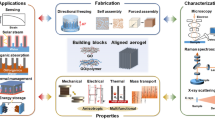The paper overviews a historical evolution of the technology, knowledge, and application of various forms and allotropic modifications of carbon as a component and base for graphitized-carbon, vapor-phase, nanostructured, and composite materials and describes the development and implementation of the synthesis of high-pressure phases and diamond-based superhard materials. The chronology of the most important developments, discoveries, and applications of carbon and associated materials is presented.
Similar content being viewed by others
References
Yu. L. Yur’ev, Charcoal: Handbook [in Russian], Sokrat, Ekaterinburg (2007), p. 184.
R. Loison, P. Foch, and A. Boyer, Coke [in French], Dunod, Paris (1970).
V. P. Zuev and V. V. Mikhailov, Carbon Black Production [in Russian], Khimiya, Moscow (1965), p. 330.
N. A. Karyakin, Searchlight and Projection Equipment [in Russian], Vysshaya Shkola, Moscow (1966), p. 411.
A. A. Chekanov, Nikolay Nikolayevich Benardos [in Russian], Nauka, Moscow (1983), p. 143.
M. Ya. Lapirov-Skoblo, Edison (Life of Remarkable People) [in Russian], Molodaya Gvardiya, Moscow (1960), p. 252.
H. O. Pierson, Handbook of Carbon, Graphite, Diamond, and Fullerenes, Noyes Publications, New Jersey, USA (1993), p. 399.
A. R. Ubellode and F. A. Lewis, Graphite and Its Crystal Compounds, Clarendon Press, Oxford (1960), p. 256.
V. S. Ostrovskii and V. I. Virgil’ev, Artificial Graphite [in Russian], Metallurgiya, Moscow (1986), p. 272.
A. S. Fialkov, Graphitized Carbon Materials [in Russian], Énergiya, Moscow (1979), p. 320.
A. S. Fialkov, Carbon, Interlayer Compounds, and Associated Composites [in Russian], Aspect-Press, Moscow (1997), p. 718.
H. von Kienle and E. Bader, Activated Carbons and Their Industrial Application [in German], Enke Verlag, Stuttgart (1980).
M. Inagaki, New Carbons. Control of Structure and Function, Elsevier (2000), p. 229.
A. S. Fialkov, A. I. Baver, N. M. Sidorov, and M. I. Chaikun, Pyrolytic Graphite [in Russian], Usp. Khim., 45, No. 10, 1731–1752 (1976).
V. D. Chekanova and A. S. Fialkov, “Vitreous carbon (preparation, properties, and application,” Rus. Chem. Rev., 40, No. 5, 413–438 (1971).
S. Shimamura, Carbon Fibers [Russian translation], Mir, Moscow (1987), p. 278.
P. Morgan, Carbon Fibers and Their Composites, Tailor and Francis, London (2005) p. 1166.
A. A. Konkin, Carbonic and Other Heat-Resistant Fibrous Materials [in Russian], Khimiya, Moscow (1974), p. 376.
A. I. Meleshko and S. P. Polkovnikov, Carbon, Carbon Fibers, and Carbon Composites [in Russian], Science Press, Moscow (2007), p. 192.
A. V. Eletskii and B. M. Smirnov, “Fullerenes and carbon structures,” Usp. Fiz. Nauk, 165, No. 9, 977–1009 (1995).
L. V. Radushkevich and V. M. Luk’yanovich, “On the structure of carbon formed in thermal decomposition of carbon oxide on iron contact,” Zh. Fiz. Khim., 26, No. 1, 88–95 (1952).
A. V. Eletskii, “Carbon nanotubes,” Usp. Fiz. Nauk, 167, No. 9, 945–972 (1997).
K. S. Novoselov, “Graphene: materials in the Flatland,” Usp. Fiz. Nauk, 181, No. 12, 1299–1311 (2011).
A. K. Geim, “Random walk to graphene,” Usp. Fiz. Nauk, No. 12, 1284–1298 (2011).
P. W. Bridgman, “Recent work in the field of high pressures,” Usp. Fiz. Nauk, 31, No. 2, 210–263 (1947).
O. I. Leipunskii, “On artificial diamonds,” Usp. Khim., 8, Issue 10, 1519–1534 (1939).
L. A. Vasiliev and Z. P. Belykh, Diamonds, Their Properties, and Application [in Russian], Nedra, Moscow (1983), p. 101.
B. V. Deryagin and D. V. Fedoseev, Gas-Phase Growth of Diamond and Graphite [in Russian], Nauka, Moscow (1977), p. 116.
V. S. Vavilov, “Diamond in solid-state electronics,” Usp. Fiz. Nauk, 167, No. 1, 17–22 (1997).
V. V. Danilenko, “From the history of discovering the synthesis of nanodiamonds,” Fiz. Tverd. Tela, 46, Issue 4, 581–584 (2004).
V. Yu. Dolmatov, “Ultrafine diamonds from detonation synthesis: properties and application,” Usp. Khim., 70, Issue 7, 687–708 (2001).
A. R. Oganov, R. J. Hemley, R. M. Hazen, and A. P. Jones, “Structure, bonding, and mineralogy of carbon in extreme conditions,” Rev. Mineral. Geochem., 75, 44–77 (2013).
Author information
Authors and Affiliations
Corresponding author
Additional information
Translated from Poroshkovaya Metallurgiya, Vol. 54, Nos. 3–4 (502), pp. 144–159, 2015.
Rights and permissions
About this article
Cite this article
Gnesin, G.G. Carbon in Inorganic Materials: From Charcoal to Graphene. Powder Metall Met Ceram 54, 241–251 (2015). https://doi.org/10.1007/s11106-015-9706-7
Received:
Published:
Issue Date:
DOI: https://doi.org/10.1007/s11106-015-9706-7




